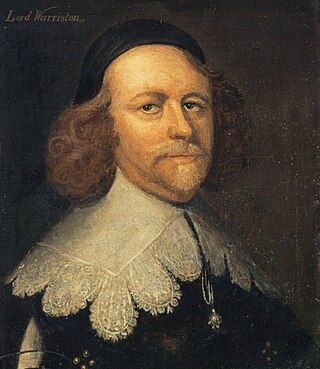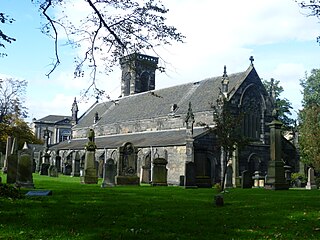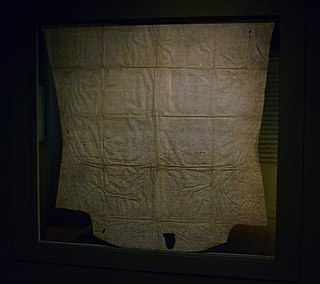
St Giles' Cathedral, or the High Kirk of Edinburgh, is a parish church of the Church of Scotland in the Old Town of Edinburgh. The current building was begun in the 14th century and extended until the early 16th century; significant alterations were undertaken in the 19th and 20th centuries, including the addition of the Thistle Chapel. St Giles' is closely associated with many events and figures in Scottish history, including John Knox, who served as the church's minister after the Scottish Reformation.

William Carstares was a minister of the Church of Scotland, active in Whig politics.

Alexander Henderson was a Scottish theologian, and an important ecclesiastical statesman of his period. He is considered the second founder of the Reformed Church in Scotland. He was one of the most eminent ministers of the Church of Scotland in the most important period of her history, namely, previous to the middle of the seventeenth century.

Sir William Allan was a distinguished Scottish historical painter known for his scenes of Russian life. He became president of the Royal Scottish Academy and was made a Royal Academician.

William Robertson FRSE FSA Scot was a Scottish historian, minister in the Church of Scotland, and Principal of the University of Edinburgh. "The thirty years during which [he] presided over the University perhaps represent the highest point in its history." He made significant contributions to the writing of Scottish history and the history of Spain and Spanish America.

The Treaty of Breda (1650) was signed on 1 May 1650 between Charles II, exiled king of England, Scotland and Ireland, and the Scottish Covenanter government. Under its terms, they agreed to install Charles II as King of Scotland and Britain, while Charles undertook to establish a Presbyterian Church of England, and guarantee the rights of the Church of Scotland.

This article is a timeline of the history of Edinburgh, Scotland, up to the present day. It traces its rise from an early hill fort and later royal residence to the bustling city and capital of Scotland that it is today.

Greyfriars Kirk is a parish church of the Church of Scotland, located in the Old Town of Edinburgh, Scotland. It is surrounded by Greyfriars Kirkyard.

Archibald Johnston, Lord Wariston was a Scottish judge and statesman.

William Wishart (1660–1729) was a Church of Scotland minister and the Principal of Edinburgh University from 1716 to 1728. He is not to be confused with his son William Wishart (secundus), who was subsequently the Principal of Edinburgh University from 1736 to 1754.

John Nisbet (1627–1685) was a Scottish covenanter who was executed for participating in the insurgency at Bothwell Brig and earlier conflicts and for attending a conventicle. He took an active and prominent part in the struggles, of the Covenanters for civil and religious liberty. He was wounded and left for dead at Pentland in 1666 but lived and fought as a captain at Bothwell Bridge, in 1679. He was subsequently seized and executed as a rebel. He was a descendant of Murdoch Nisbet, a Lollard who translated the Bible into the Scots language.

The Bishops' Wars were two separate conflicts in 1639 and 1640 fought chiefly between Scotland and England with minor factional skirmishing within Scotland. These were the first of a series known collectively as the 1639 to 1653 Wars of the Three Kingdoms which also included the First and Second English Civil Wars and the Anglo-Scottish War of 1650-1652.

Ednam Church is a member church of the Church of Scotland and is co–joined with Kelso North Church in Kelso. Ednam is in the old county of Roxburghshire now part of the Scottish Borders Council. Ednam is 3.0 miles (4.8 km) NNE of Kelso on the B6461 road and is at grid reference NT737371

Greyfriars Kirkyard is the graveyard surrounding Greyfriars Kirk in Edinburgh, Scotland. It is located at the southern edge of the Old Town, adjacent to George Heriot's School. Burials have been taking place since the late 16th century, and a number of notable Edinburgh residents are interred at Greyfriars. The Kirkyard is operated by City of Edinburgh Council in liaison with a charitable trust, which is linked to but separate from the church. The Kirkyard and its monuments are protected as a category A listed building.

Covenanters were members of a 17th-century Scottish religious and political movement, who supported a Presbyterian Church of Scotland and the primacy of its leaders in religious affairs. The name is derived from covenant, a biblical term for a bond or agreement with God.

The Restoration was the return of the monarchy to Scotland in 1660 after the period of the Commonwealth, and the subsequent three decades of Scottish history until the Revolution and Convention of Estates of 1689. It was part of a wider Restoration in the British Isles that included the return of the Stuart dynasty to the thrones of England and Ireland in the person of Charles II.
Robert Boyd, 8th Lord Boyd, was a Scottish noble and politician.

The Reformed Presbyterian Global Alliance is a communion of Presbyterians originating in Scotland in 1690 when its members refused to conform to the establishment of the Church of Scotland. The Reformed Presbyterian churches collectively have approximately 9,500 members worldwide in Northern Ireland, the Republic of Ireland, Scotland, France, the United States of America, Canada, Japan, South Sudan, and Australia.

The Hon William Robertson, Lord Robertson was an 18th-century Scottish lawyer who rose to be a Senator of the College of Justice.

The National Covenant was an agreement signed by many people of Scotland during 1638, opposing the proposed reforms of the Church of Scotland by King Charles I. The king's efforts to impose changes on the church in the 1630s caused widespread protests across Scotland, leading to the organisation of committees to coordinate opposition to the king. Facing royal opposition to the movement, its leaders arranged the creation of the National Covenant, which was designed to bolster the movement by tapping into patriotic fervour and became widely adopted throughout most of Scotland.



















